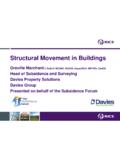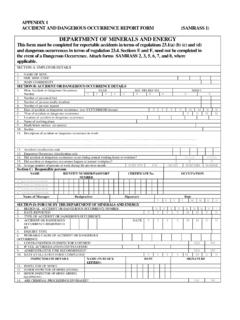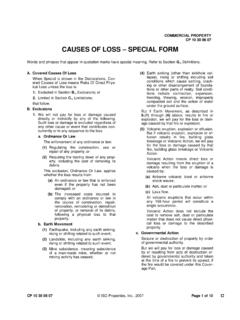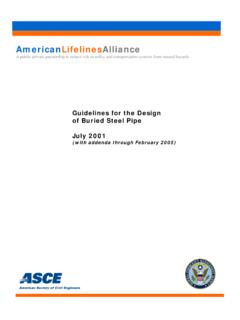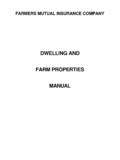Transcription of Structural Movement in Buildings - Subsidence …
1 Structural Movement in Buildings Greville Marchant C Build E MCABE, MCIOB, AssocRICS, MFPWS, CertCII Head of Subsidence and Surveying Davies Property Solutions Davies Group Presented on behalf of the Subsidence Forum Introduction The aim of this seminar is to introduce you to how to recognise the signs and cause of Structural damage to masonry structures and how to mitigate the damage before repairs are undertaken: Cracking Subsidence , Heave & Landslip Point Loading Thermal and Differential Movement Lintel failure Corrosion of embedded steelwork Bowing Lack of lateral restraint Walls too slender ( too high for their thickness) Addition of extra storeys Increased floor loads as a result of change of use Vibration Chemical Reaction and defective Design Chemical Reaction Think - jelly and marbles in a jar ! What causes Subsidence ? Cohesive soil Clay - Think Jelly - Very fine platelets:10,000 clay particles make up the thickness of a 10p coin (2mm) and the molecular forces hold water within their structure (cohesive) Non Cohesive Soil - Granular soil; Gravel and Sand - Think marbles in a jar or footballs in a What does Subsidence look like?
2 Typical crack pattern is diagonal stepped tapering cracking. Wider at the top and running through weak points such as window and door openings Cracking associated with this type of Movement generally increases in width with height wider at the top As the moisture content of clay soil changes with the seasons so the volume changes and any associated cracking may open and close (cyclical Movement ) Extensions and Bays Subsidence damage Extensions and bays can rotate away due to Subsidence Quite often the foundations are a different from the main structure Tapering cracks appear at or near the junction of the projection Point of foundation Movement Position of pivot Trees Trees and drains - two main causes Vegetation growing close to the building can cause clay shrinkage by removing moisture from the soil through their root systems. A mature oak can draw up to 1000 litres per day As the moisture content of the soil changes so the volume changes and any associated cracking may open and close (cyclical Movement ) Granular soils are generally not affected by the presence of vegetation British Geological Website Majority of shrinkable clays occur towards the South East Drains and leaks Did the drains become defective due to Subsidence or did leaking drains cause erosion or softening of clay followed by foundation Movement Erosion and washing away of fines (footballs in the box) Soakaways too close to a building or failing Softening of cohesive clay soil (turn to jelly) CCTV to establish the condition Resin Liner or replacement A symbiotic relationship between trees and drains?
3 STOOD THE TEST OF TIME so what has changed? Inadequate Foundations Generally, only a problem found on older properties and may affect all or only part of the structure (problems with garages, porches and bay windows and conservatories are particularly common) Strip foundations too narrow to adequately support imposed loads resulting in differential Movement Shallow foundations built within the shrinkable clay zone or on loose or poor made ground Heave The upward Movement of the site, normally due to expansion of a previously desiccated or shrunken clay as it rehydrates Often associated with removal of trees prior to the construction of the building Before tree removal, assessment of the risk may be necessary follow the rule of thumb a) If the tree is the same age or younger than the building there is no risk of heave b) If trees are older than an adjacent building the building was constructed on a desiccated soil; there is a possible risk of heave Opposite to Subsidence with tapered stepped diagonal cracking wider at the bottom Landslip is: Landslip Downward Movement of sloping ground resulting from the action of self-weight stresses and imposed loading (weight) exceeding the strength of the toe Three key factors Weight Water Toe stability Landslip at Scarborough, Yorkshire and collapse of Holbeck Hall Hotel (1993) Mining Sudden collapse Chalk mine in Hemel Hempstead following the Bunsfield explosion Chalk mine in Reading Mining The tavern, in Himley west Yorkshire was built as a farmhouse in 1785, got its design fault through Subsidence caused by mining during the 1800s Original photo from 1901 Current view.
4 Note lateral restraint and buttresses Sink or Swallow Holes Guatemala City 2007 - 330 foot deep 7 people reported missing This is caused by Natural erosion of limestone and soft bedrock below ground also Geological Fissures and Karstic Features Looks like, smells like and tastes like Subsidence : What s the difference? Subsidence or Settlement? Subsidence is: the downward Movement of the ground unconnected with the weight of a building and will occur whether there is a building or not Settlement is: the downward Movement of the site on which the building stands, due to the application of the superimposed load (weight) from the building Settlement Settlement problems normally exhibit themselves in the early life of the structure so older properties seldom suffer from on-going settlement Long term settlement of clay soils is normally only associated with wet ground conditions and can be visualised as a viscous liquid squeezing out of a fine sponge under a constant load Sands and gravels do not generally exhibit long term settlement as they settle immediately load is applied Concentrated Loading Point Loading Structural alterations to a building (removal of internal walls, enlargement of external windows or doorways etc.)
5 Or change of use can cause stress concentrations within localised areas of supporting brickwork Associated concentrated loading of foundations may exceed safe bearing capacity of the underlying soil and cause additional settlement Loading levels mean this is rarely a significant problem in two storey domestic construction but can be in Victorian or Georgian town houses with four or more stories where narrow brickwork piers carry excessive concentrated vertical loads Localised distress to masonry wall caused by built-in floor beam Point Loading Thermal and Differential All construction materials have the capacity to expand or contract to a greater or lesser degree as temperature varies. The combined effect of changes in temperature and moisture content within a building depend on a number of factors: The stiffness of the materials Potential for the material to creep continue to move over time under constant stress Degree of restraint ( is the material free to move, is it built-in at the ends) The resultant combined effect may result in: Oversailing of DPC Buckling (bulging of walls) Fracture of the masonry units (tension or shear) Lintel Failure Diagonal cracks above openings due to the absence, or failure, of a supporting lintel Is the supporting member strong enough to limit deflection?
6 Steel can expand up to 7 times its thickness Corrosion Wall Tie failure on cavity walls Steel lintels, railings or beams inserted into masonry No Wall ties causing bowing and peeling Wall Tie corrosion Wall Ties Vibration & Earthquake Granular soils are susceptible to consolidation by vibration and may cause Subsidence Clay soils are rarely affected by vibrations Vibrations generally only cause minor Structural damage such as cracked plaster etc. However earthquake can be devastating leading to collapse Damage may exacerbate the problems associated with other defects settlement of fill to rubble filled walls, lack of lateral restraint to external walls etc. Bowing or leaning walls associated with one or more of: Bowing Lack of lateral restraint Walls too slender ( too high for their thickness) Addition of extra storeys Increased floor loads as a result of change of use Vibration Lateral Restraint Would normally be an inherent design fault Lack of restraint is the most common cause of bowing or leaning walls Traditionally restraint is provided by the bonding in of internal and party walls Modern construction utilises the diaphragm action of the floors by connecting them to the walls with metal straps Traditional Tie Bars and Wall Plates External and internal view Lateral Restraint Internal cracking adjacent to bowing wall External Bowing The best and worst Wall Plates The best In keeping with the building The worst RSJ sections Roof Spread Roof spread is caused when the weight of the roof produces a horizontal outward force at the top of the walls (triangle wants to flatten).
7 The tops of the walls can be visibly displaced and cracks appear at the junctions between the external walls and internal partitions/ceilings Remedial works generally involve the installation of collar beams to tie between the rafters thus resisting the outward forces Chemical Reactions Clay bricks contain soluble sulphate salts which may appear as efflorescence on the surface. When wet they react with the Portland cement within the bedding mortar producing a significant increase in volume This expansion of the mortar can cause spalling, bowing of the wall and cracking of applied surface finishes such as render, pebbledash etc. Differing moisture conditions to opposite sides of a wall can result in differential Movement . Parapet walls, earth retaining walls, chimney breasts are very susceptible to damage Retaining Wall Parapet Wall Chimney Stack Under floor fill material Chemical Reaction Generally downwards Movement occurs (settlement), but it can be upwards -SLAG!
8 - Expands when wet Concrete Cancers Steel corrosion Water expands by 9% when it freezes Frost When water is trapped in the pores of porous building materials ( brick, stone, mortar) freezes the resulting expansion can cause the base material to spall and mortar to become friable Damage is exacerbated by repeated freeze/thaw cycles Non-porous coatings to external face of Buildings can trap water within the substrate and induce subsequent damage Resultant damage is initially limited to the crumbling and flaking of the exposed external face but left untreated can cause Structural problems Defective Design Given the knowledge of the site and the technical standards prevailing at the time of construction Collapsed building in Shanghai 2009 Damage Assessment Is the cracking diagonal, vertical or horizontal? Does the cracking taper in width from one end to the other? Does the crack pattern indicate a particular direction of Movement or mechanism?
9 Are the cracks historic or is there evidence of recent Movement ? Is the external wall leaning or bulging? Is the whole wall moving or is it just the outer skin? Are masonry bed joints, window head, cills floors etc. level? Are the walls plumb? Are door and window frames square? Have any previous repair works been carried out? Careful analysis of the above factors is essential to allow an accurate assessment of the cause of the damage to be made Often more than one type of damage can be identified within a structure The factors that should be considered during a survey are: BRE DIGEST 251 Category of Damage Category Crack width Definition Action 0 Hairline Hairline cracking which is normally indistinguishable from other causes such as shrinkage and thermal Movement No action required 1 Up to 1mm Damage generally restricted to internal wall finishes; cracks rarely visible in external brickwork Fine cracks which can easily be treated during normal decoration.
10 2 Up to 5mm Cracks not necessarily visible externally; Doors and windows may stick slightly and require easing and adjusting. Cracks easily filled. Recurrent cracks can be masked by suitable linings some repointing may be required externally to ensure weather tightness. 3 5 15mm Doors and windows sticking. Service pipes may fracture. Weather tightness often impaired. Cracks which require some opening up and patching by a mason. Repointing of external brickwork and possibly a small amount of brickwork to be replaced. 4 15 25mm Windows and doorframes distorted, floor sloping noticeably. Walls leaning or bulging noticeably, some loss of bearing in beams. Service pipes disrupted. Extensive damage that requires breaking-out and replacing sections of walls, especially over doors and windows. May require partial rebuilding 5 Greater than 25mm Beams lose bearing, walls lean badly and require shoring. Windows broken with distortion. Danger of instability Structural damage which requires a major repair job involving partial or complete rebuilding.
